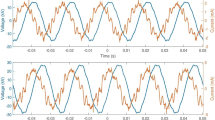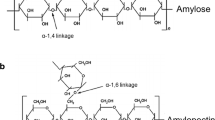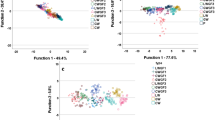Abstract
Seaweeds as food and seaweed-derived food flavors, colors, and nutrients are attracting considerable commercial attention. In the baking industries, hydrocolloids are of increasing importance as bread making improvers, where their use aims to improve dough handling properties, increase the quality of fresh bread, and extend the shelf life of stored bread. Seaweeds contain a significant amount of soluble polysaccharides and have the potential function as a source of dietary fiber. In this study, red seaweed (Kappaphycus alvarezii) powder was incorporated (2–8 %) with wheat flour and used to produce bread. The effect of seaweed composite flour on dough rheological properties and the quality of bread was investigated using various techniques. Farinograph tests were applied to determine the effect of seaweed powder on the rheological properties of wheat flour dough, while texture profile analysis (TPA) was used to measure the textural properties of dough as well as the final product. The results showed that the additions of seaweed powder (2–8 %) increased the water absorption of the dough. TPA results showed that the addition of seaweed powder decreased stickiness properties. Bread produced with seaweed composite flour showed higher values of firmness.




Similar content being viewed by others
References
AACC (1983) Approved methods of the American Associations of Cereal Chemists. American Association of Cereal Chemists, St. Paul (Method 08-01, 44-15A)
AACC (1986) Approved methods of the American association of cereal chemists (8th ed.). American Association of Cereal Chemists, St. Paul (Methods 74-09)
AACC (1999) Approved methods of the American Associations of Cereal Chemists. American Association of Cereal Chemists, St. Paul (Method 74-10.02)
Armero E, Collar C (1996) Antistaling additives, flour type and sourdough process effects on functionality of wheat doughs. J Food Sci 61:299–303
Armero E, Collar C (1998) Crumb firming kinetics of wheat breads with anti-staling additives. J Cereal Sci 28:165–174
Bell DA (1990) Methylcellulose as structure enhancer in bread baking. Cereal Foods World 35:1001–1006
Brownlee IA, Allen A, Pearson JP, Dettmar PW, Havler ME, Atherton MR (2005) Alginate as a source of dietary fiber. Crit Rev Food Sci Nutr 45:497–510
Christianson DD, Gardner HW, Warner K, Boundy BK, Inglett GE (1974) Xanthan gum in protein-fortified starch bread. Food Technol 28(6):23–29
Davidou S, Le Meste M, Debever E, Bekaert D (1996) A contribution to the study of staling of white bread: effect of water and hydrocolloid. Food Hydrocoll 10:375–383
Dickinson E (2003) Hydrocolloids at interfaces and the influence on the properties of dispersed systems. Food Hydrocoll 17:25–39
Draget KI (2000) Alginates. In: Phillips GO, Williams PA (eds) Handbook of hydrocolloids. Woodhead, England, pp 379–395
Dziezak JD (1991) A focus on gums. Food Technol 45:115–132
Friend CP, Waniska FR, Rooney LW (2003) Effects of hydrocolloids on processing and qualities of wheat tortillas. Cereal Chem 70:252–256
Gill S, Vasanthan T, Ooraikul B, Rossnagel B (2002) Wheat bread quality as influenced by the substitution of waxy and regular barley flours in their native and extruded forms. J Cereal Sci 36:219–237
Guarda A, Rosell CM, Benedito de Barber C, Galotto MJ (2004) Different hydrocolloids as bread improvers and antistaling agents. Food Hydrocoll 18:241–247
Hoefler AC (2004) Hydrocolloids. Eagan Press, St. Paul
Khotimchenko YS, Kovalev VV, Savchenko OV, Ziganshina OA (2001) Physical–chemical properties, physiological activity, and usage of alginates, the polysaccharides of brown algae. Russ J Mar Biol 27:S53–S64
Miller BS, Trimbo HB (1965) Gelatinization of starch and white layer cake quality. Food Technol 19:640–648
Mettler E, Seibel W (1995) Optimizing of rye bread recipes containing mono-diglyceride, guar gum, and carboxymethylcellulose using a maturograph and an oven rise recorder. Cereal Chem 72:109–115
Mohamed AA, Rayas-Duarte P, Shogren RL, Sessa DJ (2006) Low carbohydrates bread: formulation, processing and sensory quality. Food Chem 99:686–692
Ribotta PD, Pérez GT, León AE, Anon MC (2004) Effect of emulsifier and guar gum on micro structural, rheological and baking performance of frozen bread dough. Food Hydrocoll 18:305–313
Rojas JA, Rosell CM, Benedito de Barber C (1999) Pasting properties of different wheat flour-hydrocolloids systems. Food Hydrocoll 13:27–33
Rodge AB, Sonkamble SM, Salve RV, Hashmi SI (2012) Effect of hydrocolloid (guar gum) incorporation on the quality characteristics of bread. J Food Process Technol 3:136. doi:10.4172/2157-7110.1000136/
Rosell CM, Rojas JA, Benedito de Barber C (2001a) Combined effect of different antistaling agents on the pasting properties of wheat flour. Eur Food Res Technol 212:473–476
Rosell CM, Rojas JA, Benedito de Barber C (2001b) Influence of hydrocolloids on dough rheology and bread quality. Food Hydrocoll 15:75–81
Sangnark A, Noomhorm A (2004) Effect of dietary fiber from sugarcane bagasse and sucrose ester on dough and bread properties. Lebensm Wiss Technol 37:697–704
Stauffer CE (1990) Functional additives for bakery foods. Van Nostrand Reinhold, New York
Wade P (1988) Biscuits, cookies and crackers: Vol. 1. The principles of the craft. Elsevier, Essex
Ylimaki G, Hawrysh ZJ, Hardin RT, Thomson ABR (1998) Application of response-surface methodology to the development of rice flour yeast breads—objective measurements. J Food Sci 53:1800–1805
Acknowledgments
The authors would like to thank the Seaweed Research Unit, Universiti Malaysia Sabah for awarding this research grant.
Author information
Authors and Affiliations
Corresponding author
Electronic supplementary material
Below is the link to the electronic supplementary material.
ESM 1
(JPEG 1506 kb)
Rights and permissions
About this article
Cite this article
Mamat, H., Matanjun, P., Ibrahim, S. et al. The effect of seaweed composite flour on the textural properties of dough and bread. J Appl Phycol 26, 1057–1062 (2014). https://doi.org/10.1007/s10811-013-0082-8
Received:
Revised:
Accepted:
Published:
Issue Date:
DOI: https://doi.org/10.1007/s10811-013-0082-8




